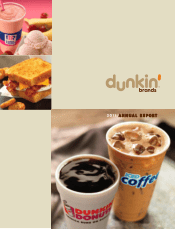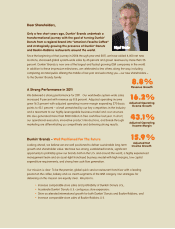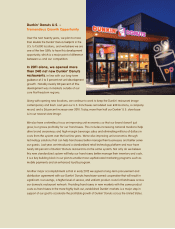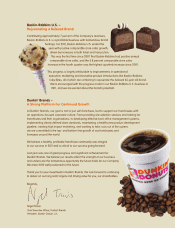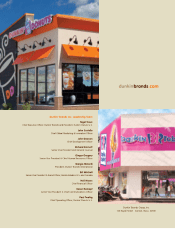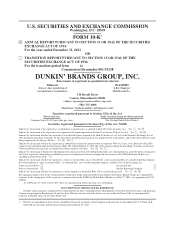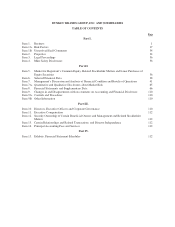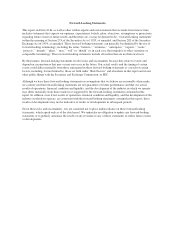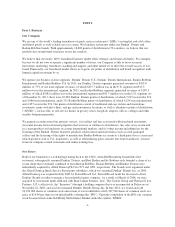Baskin Robbins 2011 Annual Report Download - page 11
Download and view the complete annual report
Please find page 11 of the 2011 Baskin Robbins annual report below. You can navigate through the pages in the report by either clicking on the pages listed below, or by using the keyword search tool below to find specific information within the annual report.PART I
Item 1. Business .
Our Company
We are one of the world’s leading franchisors of quick service restaurants (“QSRs”) serving hot and cold coffee
and baked goods, as well as hard serve ice cream. We franchise restaurants under our Dunkin’ Donuts and
Baskin-Robbins brands. With approximately 16,800 points of distribution in 58 countries, we believe that our
portfolio has strong brand awareness in our key markets.
We believe that our nearly 100% franchised business model offers strategic and financial benefits. For example,
because we do not own or operate a significant number of stores, our Company is able to focus on menu
innovation, marketing, franchisee coaching and support, and other initiatives to drive the overall success of our
brand. Financially, our franchised model allows us to grow our points of distribution and brand recognition with
limited capital investment by us.
We operate our business in four segments: Dunkin’ Donuts U.S., Dunkin’ Donuts International, Baskin-Robbins
International and Baskin-Robbins U.S. In 2011, our Dunkin’ Donuts segments generated revenues of $453.0
million, or 75% of our total segment revenues, of which $437.7 million was in the U.S. segment and $15.3
million was in the international segment. In 2011, our Baskin-Robbins segments generated revenues of $150.3
million, of which $108.6 million was in the international segment and $41.7 million was in the U.S. segment. As
of December 31, 2011, there were 10,083 Dunkin’ Donuts points of distribution, of which 7,015 were in the U.S.
and 3,068 were international, and 6,711 Baskin-Robbins points of distribution, of which 4,254 were international
and 2,457 were in the U.S. Our points of distribution consist of traditional end-cap, in-line and stand-alone
restaurants, many with drive thrus, and gas and convenience locations, as well as alternative points of distribution
(“APODs”), such as full- or self-service kiosks in grocery stores, hospitals, airports, offices, colleges and other
smaller-footprint properties.
We generate revenue from four primary sources: (i) royalties and fees associated with franchised restaurants;
(ii) rental income from restaurant properties that we lease or sublease to franchisees; (iii) sales of ice cream and
ice cream products to franchisees in certain international markets; and (iv) other income including fees for the
licensing of the Dunkin’ Donuts brand for products sold in non-franchised outlets (such as retail packaged
coffee) and the licensing of the rights to manufacture Baskin-Robbins ice cream to a third party for ice cream and
related products sold to U.S. franchisees; as well as refranchising gains, transfer fees from franchisees, revenue
from our company-owned restaurants and online training fees.
Our history
Both of our brands have a rich heritage dating back to the 1940s, when Bill Rosenberg founded his first
restaurant, subsequently renamed Dunkin’ Donuts, and Burt Baskin and Irv Robbins each founded a chain of ice
cream shops that eventually combined to form Baskin-Robbins. Baskin-Robbins and Dunkin’ Donuts were
individually acquired by Allied Domecq PLC in 1973 and 1989, respectively. The brands were organized under
the Allied Domecq Quick Service Restaurants subsidiary, which was renamed Dunkin’ Brands, Inc. in 2004.
Allied Domecq was acquired in July 2005 by Pernod Ricard S.A. Pernod Ricard made the decision to divest
Dunkin’ Brands in order to remain a focused global spirits company. As a result, in March of 2006, we were
acquired by investment funds affiliated with Bain Capital Partners, LLC, The Carlyle Group and Thomas H. Lee
Partners, L.P. (collectively, the “Sponsors”) through a holding company that was incorporated in Delaware on
November 22, 2005, and was later renamed Dunkin’ Brands Group, Inc. In July 2011, we issued and sold
22,250,000 shares of common stock and certain of our stockholders sold 3,337,500 shares of common stock at a
price of $19.00 per share in our initial public offering (the “IPO”). Upon the completion of the IPO, our common
stock became listed on the NASDAQ Global Select Market under the symbol “DNKN.”
-1-

